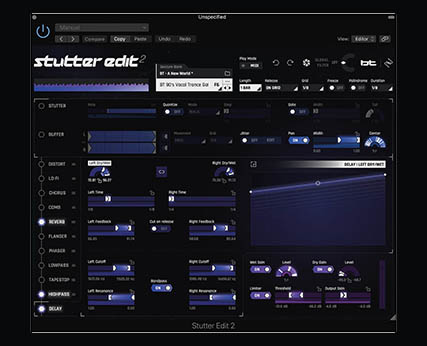Stutter Edit 2 is an epic plugin from iZotope and the legendary producer, BT.
The plugin allows you to slice and dice your samples, mixes and tracks. Gone are the days of spending hours manually chopping up audio and rearranging it to create rhythmic patterns in your songs. Creating that famous stutter effect is now easily achievable with just the click of a button.
Fans of BT's creative genius will be in for a treat with hundreds of presets designed by the man himself included with the plugin.
How Does It Work?
Stutter Edit 2 has hundreds of presets (gestures) you can audition in seconds with Auto mode. You simply add Stutter Edit 2 to the FX chain of the desired track and it does all the slicing and dicing for you. Each gesture behaves differently, and produces different intricate rhythmic patterns to add interest and movement to your arrangements. You can hear a range of the presets in action here.
You can choose to trigger Stutter Edit 2 presets in 2 different ways, via either Auto or MIDI mode.
Auto Mode
Take an audio track containing a breakbeat for example, you place stutter edit in the FX chain, choose Auto mode and it will instantly effect the audio, slicing and dicing the breakbeat. You can activate one preset at a time in Auto mode switching through manually, and then automate the device on and off to select different parts of the beat to process. This is the simplest way to work with the effect.
MIDI Mode
The MIDI mode allows you to trigger any of presets in a bank by playing MIDI notes (each preset is mapped to a different key). So MIDI mode could prove an innovative feature for any live performers that want to incorporate Stutter Edit 2 into their performance.
MIDI mode requires a little more set up than the Auto mode because you need to route MIDI data (from a separate MIDI track) into the effect. After the brief setup though, you can then access the full range of presets and launch them in a tactile fashion by playing notes on your keyboard, so it's the preferable mode by far!
FX In Stutter Edit 2
Stutter Edit 2 also has a superb range of studio quality FX that can be arranged in a customisable FX chain, and each effect can be turned on or off individually.
All FX are synced to the timing of your stutter edit, making it super easy to add filter sweeps, panning FX, pumping dynamics like sidechains and more. If the presets aren’t doing your ears justice you can draw your own patterns in the Curve editor. Rhythmically controlling any parameter, you can start off with any 12 pre-made curves and edit or just draw your own. Stutter Edit 2 also features a global filter, enabling you to filter the entire edit; stutter pattern and FX.
The layout of this plugin is just beautiful; the visual menu for stutter and module settings is really intuitive and clear. In trying out this plugin, it was the first of it’s kind for me and I was blown away with the range of options on offer. Producers in need of inspiration could definitely find new ideas by employing stutter edit on a sample and toying around.
I found my way around it after an hour or so, then didn’t move from my DAW for a few hours after!
Next Level Automation!
Virtually every parameter on Stutter Edit can be modulated, meaning its value changed over time rather than remaining static. This offers a huge amount of control over the way the sound is processed. Everything from filter frequencies and delay times, to dry/wet blends and distortion drives is available for modulating. Furthermore, every parameter gets its own individual curve, which can be drawn precisely the way you want. It really is an unprecendented amount of modulation!
Stutter & Buffer
At the heart of Stutter Edit are the Stutter and Buffer sections. Stutter is essentially a beat repeater - like a delay only one that repeats indefintely, stays at max level and doesn't fade out. Buffer is an extension of the Stutter section that allows you to control the part of the signal that's being stuttered. For an explanation of the Buffer, check out this sample lesson from Rob Jones' new course Producertech's Producer's Guide To Stutter Edit 2:
Purchase iZotope’s Stutter Edit 2



